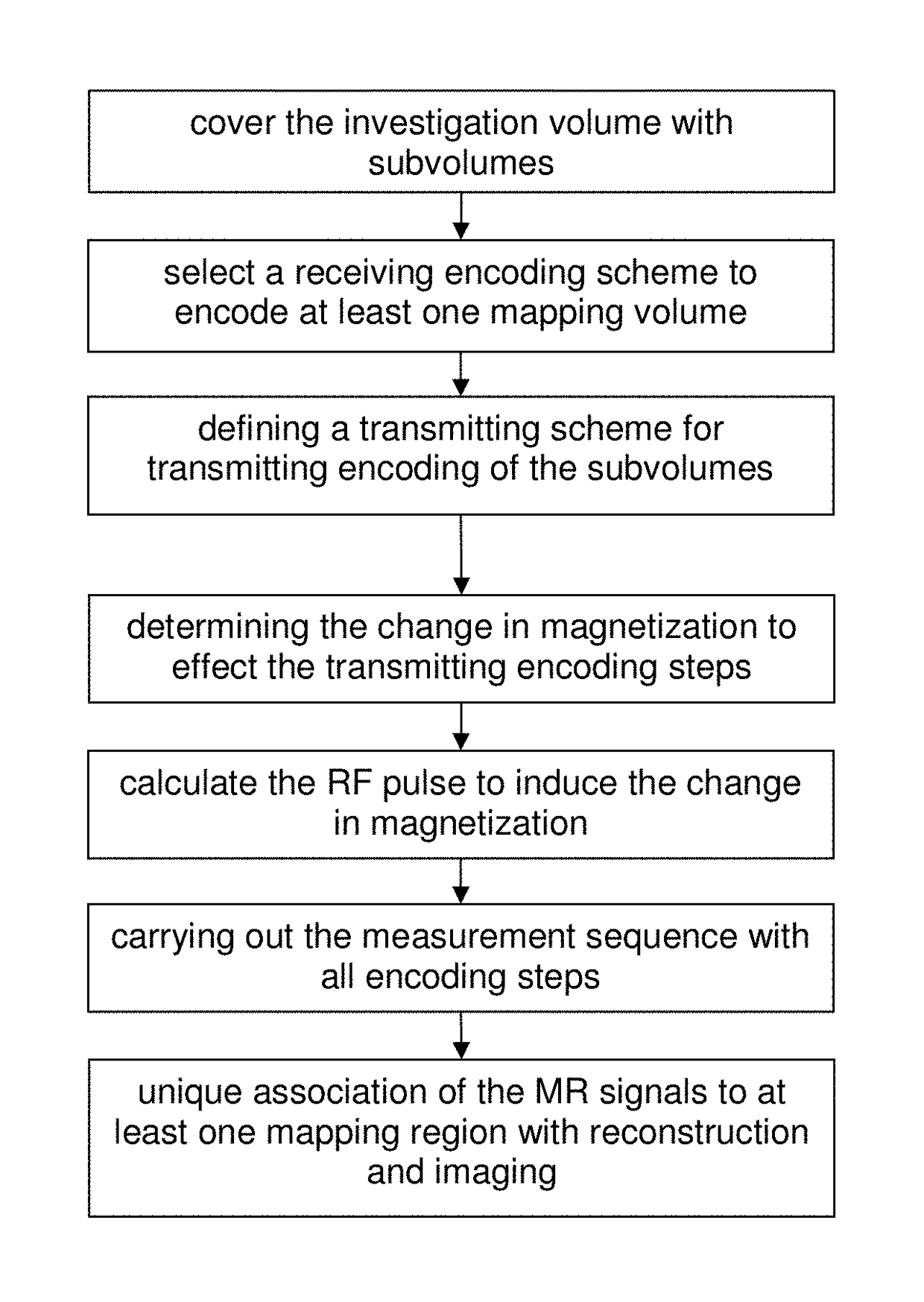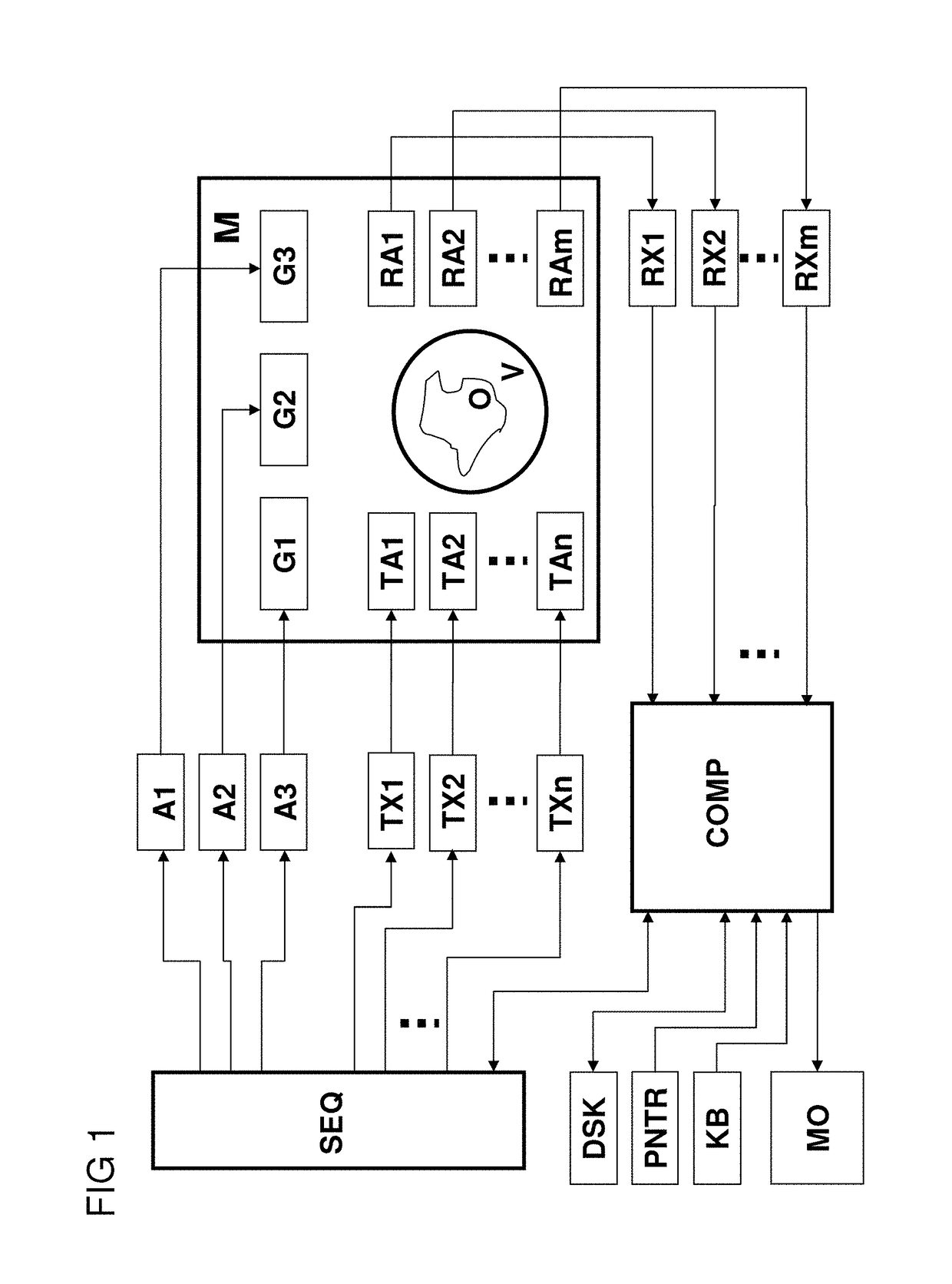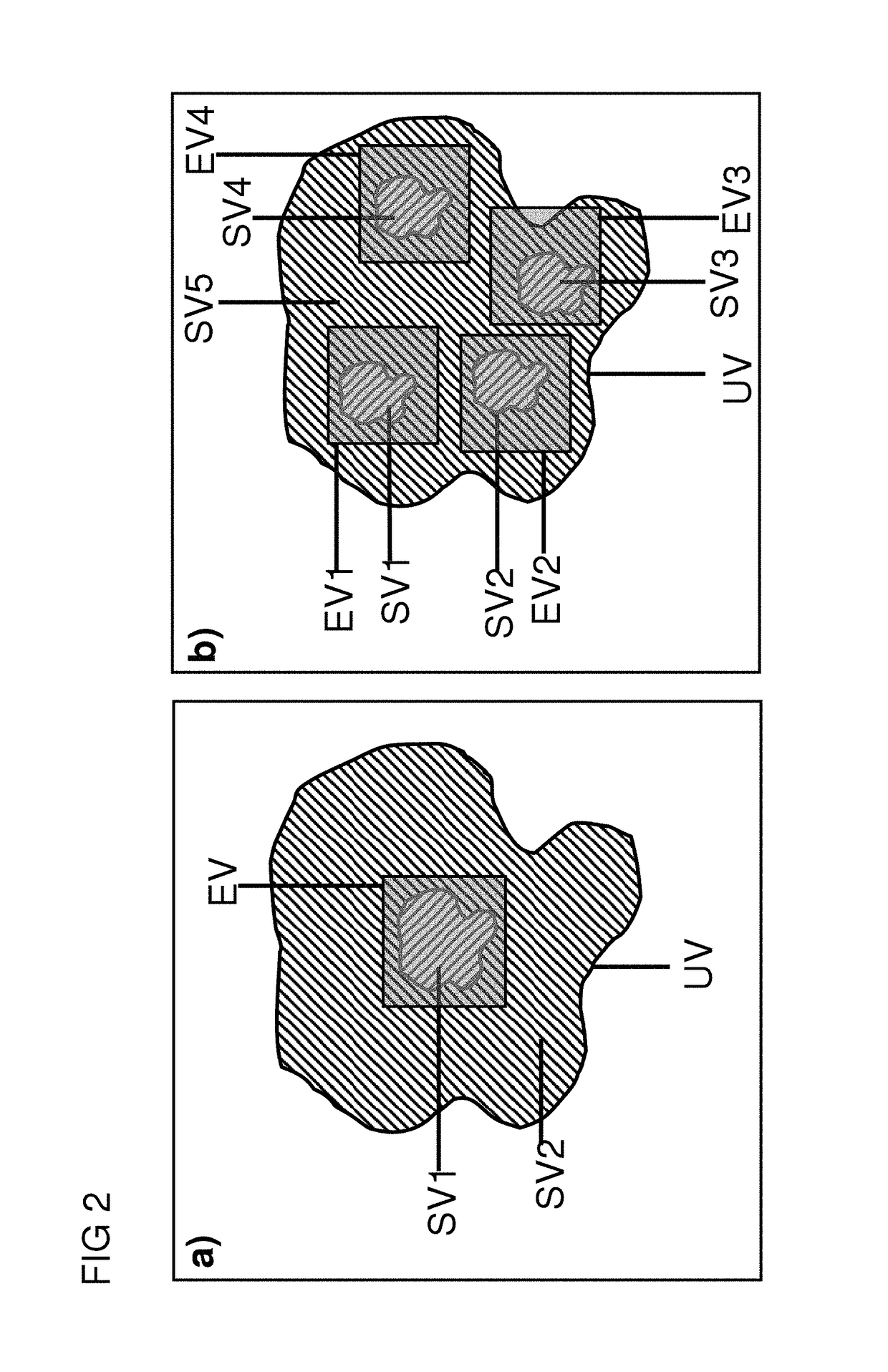[0013]Multi-dimensional, spatially selective excitation by means of multi-dimensional RF pulses [3], in which the excitation volume is restricted in more than one direction and / or the excitation is modulated in more than one direction, has also yielded numerous applications. These include excitation of a small three-dimensional volume or several volumes simultaneously within a much larger object under examination for localized spectroscopy, the mapping of a selectively excited region (ROI: region of interest) with a reduced field of view (FOV) with the aim of reducing the measurement time, the excitation of special volumes adapted to structures of the object under examination, or echo-planar imaging with reduced echo train lengths. The amplitude and phase modulation of the transverse magnetization in the excitation can also be used to compensate for disadvantageous effects of a non-homogeneous magnetic transmission field (B1 field) of the RF transmission antennas used for excitation. This is an application that has become considerably more important today due to the large increase in high-field MRI systems on which such non-homogeneities occur especially frequently. In addition to its use for excitation, multi-dimensional RF pulses can also be used for spatially selective inversion or refocusing of the magnetization.
[0014]MRI and MRS methods are also known in which nuclear spins within one or more spatially separated areas under examination, and only there, are simultaneously excited selectively by means of multidimensional RF excitation and, during this excitation, a phase encoding is superposed onto the magnetic resonance signals by means of a suitable encoding scheme, which if the magnetic resonance signals of all areas under examination are acquired simultaneously, permits separation of the signals according to the area they originate from and / or determination of their spatial distribution within these areas [4].
[0015]According to the method disclosed in [5], it is also possible to create phase patterns of transverse magnetization during excitation in order to achieve partial or full spatial encoding of the magnetic resonance signals during excitation. By repeating excitation with different phase patterns as defined by a phase encoding scheme, an entire data set is collected in multiple phase encoding steps, which is then reconstructed spatially resolved according to the spatial encoding scheme and which provides, for example, two- or three-dimensional images of the object under examination. This method of spatial encoding will hereinafter be referred to as excitation encoding. Analogously, this method of spatial encoding with RF transmission phases can also be applied with spatially selective inversion or refocusing. Generally, the term transmission encoding will be used from now on when spatial encoding of the magnetization is generally applied during irradiation of spatially selective RF pulses.
[0016]For the practical use of mufti-dimensional RF pulses, a further aspect of technical progress of the past few has years has proven advantageous, which is described in detail in [6]. In the past, the spatially selective excitation was initially performed using a single RF transmission antenna with an essentially homogeneous transmission field (B1 field) in conjunction with the gradient system. Inspired by the success of parallel imaging, in which signal acquisition is performed with RF reception antenna equipment with multiple reception elements, also termed antenna array in the specialist literature, it has now become customary to also use such RF transmission antenna devices, which consist of multiple transmission elements operated on multiple, independent RF transmission channels of the MR apparatus, for transmission in spatially selective excitation. In this way, it is possible to partially replace the spatial encoding, which in the case of multi-dimensional RF pulses by analogy with data acquisition is implemented by varying additional magnetic fields, with so-called sensitivity encoding and thus to reduce the length of the excitation pulses. This enables use of the different spatial variations of the RF transmission fields of the individual array elements, hereinafter also referred to as transmission profiles.
[0017]Because, in the case of one-channel transmission, the length of selective excitation pulses is usually one of the criteria limiting the applicability of this technique, parallel excitation (PEX) or mufti-channel excitation is a promising approach by which spatially selective excitation may be deployed more widely than it has been. Spatial encoding during transmission of RF pulses for the purpose of selective excitation, hereinafter referred to as spatial RF pulse encoding, enables the amplitude and phase of the transverse magnetization produced during transmission to be set depending on the location. This spatial RF pulse encoding differs both from classic acquisition spatial encoding, hereinafter referred to as reception encoding, which is performed without RF injection as part of data acquisition in a period following the excitation, in particular, during data acquisition (e.g. as phase, frequency, or sensitivity encoding), and also from the transmission or excitation encoding mentioned above, in which spatial-encoding amplitude or phase distributions of the transverse magnetization of the nuclear spins are generated in multiple encoding steps by means of spatially selective RF pulses.
[0018]One of the basic issues when using spatially selective excitation is determination of the RF pulses to be replayed by the transmission antenna device to generate the desired excitation pattern in conjunction with additional magnetic fields, e.g. by describing a k-space trajectory. In [3], Pauly et al. describe a method for single-channel spatially selective excitation with which, by a mathematical analogy of the selective excitation with Fourier imaging, the pulse form B1(t) to be attained can essentially be calculated by Fourier transformation of the desired excitation pattern and sampling of the Fourier transform along the prescribed k-space trajectory. Katscher et al. extend this calculation method to cover an antenna array with multiple independent transmission channels [6].
 Login to View More
Login to View More  Login to View More
Login to View More 


